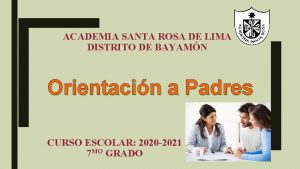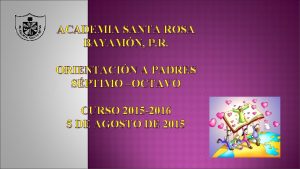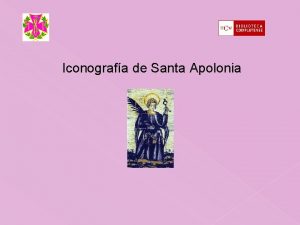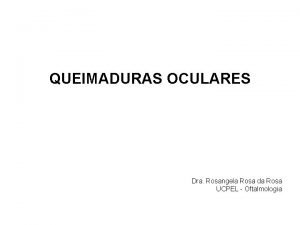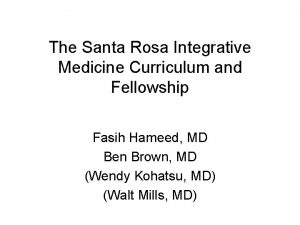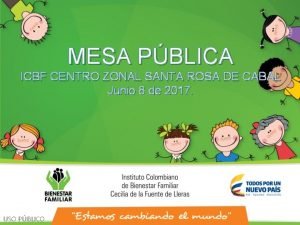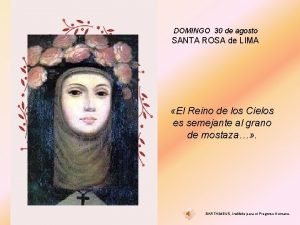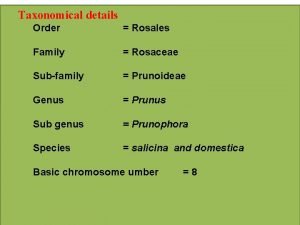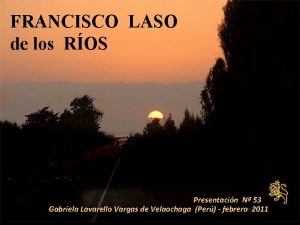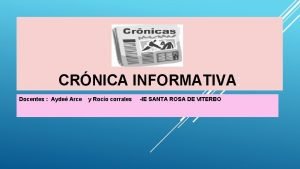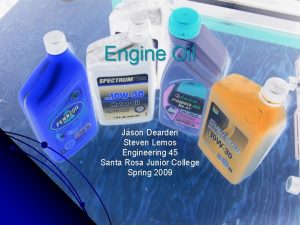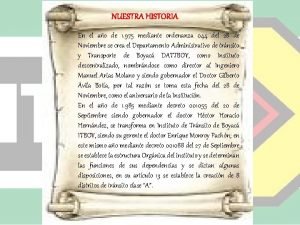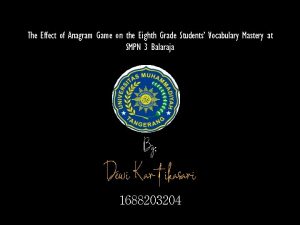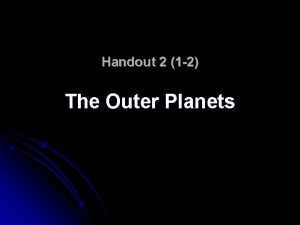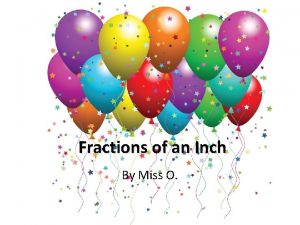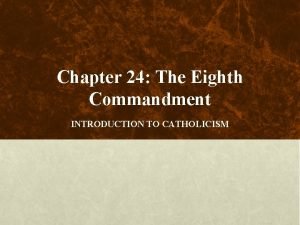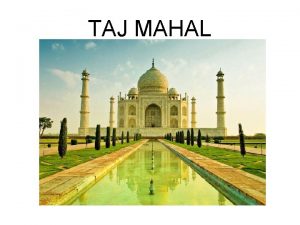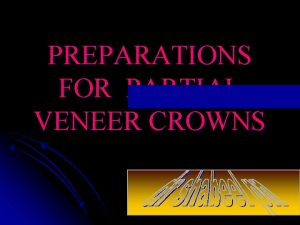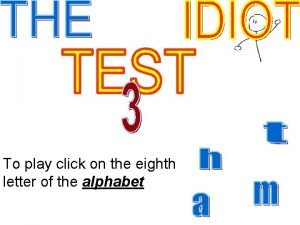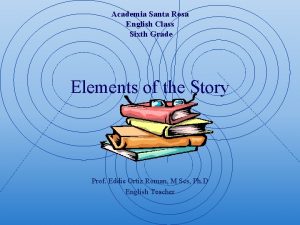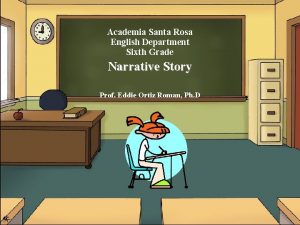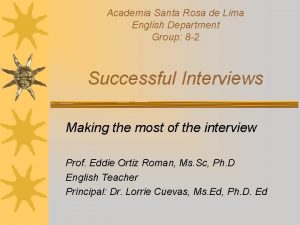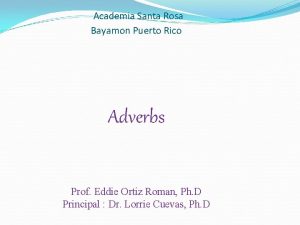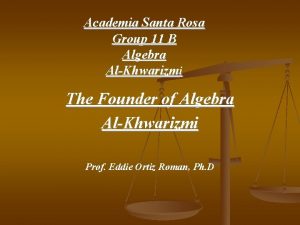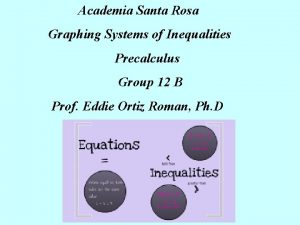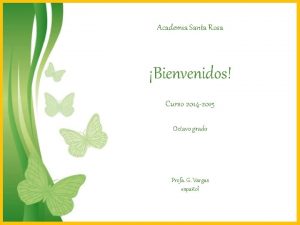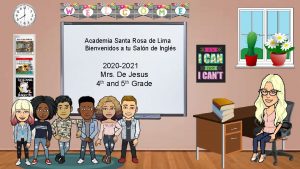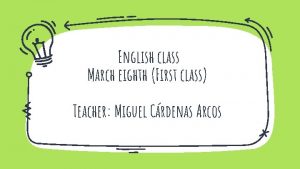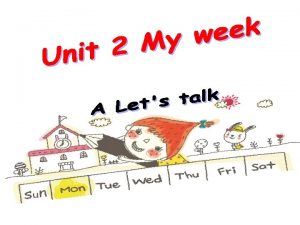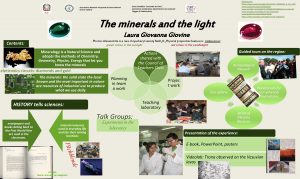Academia Santa Rosa English Class Eighth Grade 8




























- Slides: 28

Academia Santa Rosa English Class Eighth Grade 8 -2 Elements of the Story Prof. Eddie Ortiz Roman, M Scs, Ph. D English Teacher Principal: Dr. Lorrie Cuevas Torres, M. S, Ed, Ph. D, Ed

Story Elements ØSetting ØCharacters ØPlot ØConflict ØResolution ØPoint of View ØTheme

Setting • Setting is the “where and when” of a story. It is the time and place during which the story takes place.

Setting Time and place are where the action occurs Details that describe: ü Furniture ü Scenery ü Customs ü Transportation ü Clothing ü Dialects ü Weather ü Time of day ü Time of year

The Functions of a Setting Ø To create a mood or atmosphere Ø To show a reader a different way of life Ø To make action seem more real Ø To be the source of conflict or struggle Ø To symbolize an idea

Mood • Mood is the feeling that the author tries to convey throughout the story. The atmosphere or emotional condition created by the piece, within the setting. Does the author want the reader to be frightened or sad, or does the story make the reader laugh and think happy thoughts? • To figure out mood, examine how you feel while reading the story. Often mood is conveyed by the story’s setting.

Characters • The person, animals, and things participating in a story

Characters • Protagonist and antagonist are used to describe characters. • The protagonist is the main character of the story, the one with whom the reader identifies. This person is not necessary “good”. • The antagonist is the force in opposition of the protagonist; this person may not be “bad” or “evil”, but he/she opposes the protagonist in a significant way

Plot (definition) • Plot is the organized pattern or sequence of events that make up a story. • Plot is the literary element that describes the structure of a story. It shows arrangement of events and actions within a story.

Parts of a Plot Ø Exposition - introduction; characters, setting and conflict (problem) are introduced Ø Rising Action- events that occur as result of central conflict Ø Climax- highest point of interest or suspense of a story Ø Falling Action - tension eases; events show the results of how the main character begins to resolve the conflict Ø Resolution- loose ends are tied up; the conflict is solved

Plot Diagram 3 2 1 4 5

1. Exposition • This usually occurs at the beginning of a short story. Here the characters are introduced. We also learn about the setting of the story. Most importantly, we are introduced to the main conflict (main problem).

2. Rising Action • This part of the story begins to develop the conflict(s). A building of interest or suspense occurs and leads to the climax. Complications arise

3. Climax • This is the turning point of the story. Usually the main character comes face to face with a conflict. The main character will change in some way. This is the most intense moment.

4. Falling Action • Action that follows the climax and ultimately leads to the resolution

5. Resolution • The conclusion; all loose ends are tied up. • Either the character defeats the problem, learns to live with the problem, or the problem defeats the character.

Putting It All Together 1. Exposition 2. Rising Action 3. Climax 4. Falling Action 5. Resolution Beginning of Story Middle of Story End of Story

Diagram of Plot Setting, characters, and conflict are introduced ling Fal on i Act Introduction/ Exposition De Ris velo ing pme Ac nt/ tio n Climax Resolution

Special Techniques used in a Story Ø Suspense- excitement, tension, curiosity Ø Foreshadowing- hint or clue about what will happen in story Ø Flashback- interrupts the normal sequence of events to tell about something that happened in the past Ø Symbolism – use of specific objects or images to represent ideas Ø Personification – when you make a thing, idea or animal do something only humans do Ø Surprise Ending - conclusion that reader does not expect

Conflict is the dramatic struggle between two forces in a story. Without conflict, there is no plot.

Conflict ØConflict is a problem that must be solved; an issue between the protagonist and antagonist forces. It forms the basis of the plot. ØConflicts can be external or internal üExternal conflict- outside force may be person, group, animal, nature, or a nonhuman obstacle üInternal conflict- takes place in a character’s mind

Types of External Conflict Character vs Nature Character vs Society Character vs Fate

Type of Internal Conflict Character vs. Self

Point of View • First Person Point of View- a character from the story is telling the story; uses the pronouns “I” and “me” • Third Person Point of View- an outside narrator is telling the story; uses the pronouns “he”, “she”, “they”

Types of Third-Person Point of View • Third-Person Limited • Third-Person Omniscient • The narrator knows the thoughts and feelings on only ONE character in a story. thoughts and feeling of ALL the characters in a story.

Theme ØThe theme is the central, general message, the main idea, the controlling topic about life or people the author wants to get across through a literary work ØTo discover theme of a story, think big. What big message is the author trying to say about the world in which we live? ØWhat is this story telling me about how life works, or how people behave?

The Theme is also • The practical lesson ( moral) that we learn from a story after we read it. The lesson that teaches us what to do or how to behave after you have learned something from a story or something that has happened to you. Example: The lesson or teaching of the story is be careful when you’re offered something for nothing.

Remember to study and practice
 Academia santa rosa de lima blog de maestros
Academia santa rosa de lima blog de maestros Academia santa rosa de lima
Academia santa rosa de lima Santa apolonia santa rosa
Santa apolonia santa rosa Rosangela rosa da rosa
Rosangela rosa da rosa Integrative medicine santa rosa
Integrative medicine santa rosa Kaiser santa rosa er
Kaiser santa rosa er Centro zonal santa rosa de cabal
Centro zonal santa rosa de cabal Domingo 30 de agosto santa rosa de lima
Domingo 30 de agosto santa rosa de lima Misioneras de santa rosa de lima
Misioneras de santa rosa de lima City of santa rosa jobs
City of santa rosa jobs Rosaceae classification
Rosaceae classification Pediatric asthma care near santa rosa
Pediatric asthma care near santa rosa Quien pintó la pascana
Quien pintó la pascana Frases de santa rosa de viterbo
Frases de santa rosa de viterbo Tap plastics santa rosa
Tap plastics santa rosa Jason dearden
Jason dearden Itboy santa rosa de viterbo citas
Itboy santa rosa de viterbo citas Escuela santa rosa de chena
Escuela santa rosa de chena Anagram of eighth
Anagram of eighth Psychology eighth edition david g myers
Psychology eighth edition david g myers Eighth planet from the sun
Eighth planet from the sun Quarter inch fraction
Quarter inch fraction Reuptake psychology
Reuptake psychology The fifth, sixth, seventh, and eighth amendments protect *
The fifth, sixth, seventh, and eighth amendments protect * What is the eighth commandment catholic
What is the eighth commandment catholic Taj mahal wonder of the world
Taj mahal wonder of the world Reverse three-quarter crown
Reverse three-quarter crown Eighth amendment excessive bail
Eighth amendment excessive bail Eighth letter of the alphabet
Eighth letter of the alphabet
